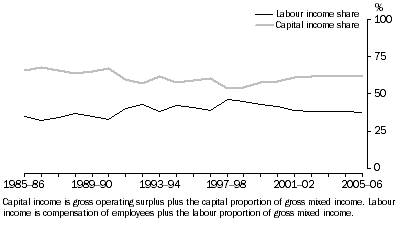INCOME SHARES
Figure 3.5 demonstrates that there was also an increasing capital share of income from the late 1990s onwards. The increasing income share of capital meant that capital was weighted as an increasingly important component of the input. This, coupled with the greater flow of capital services relative to labour inputs (figure 3.2), meant that there was a significant increase in the input index over the last few years.
The Agriculture, forestry & fishing industry has a notable complication in the calculation of the capital and labour shares of income because it has such a large unincorporated sector. Unincorporated enterprises contribute a significant proportion of the industry's income. The complication arises because it is unclear how income from this sector as measured by gross mixed income (GMI) should be attributed between a return to labour and a return to capital. This has been done by estimating implicit labour and capital income using average compensation per hour received by wage and salary earners and the corporate rental price respectively. For more details see Australian System of National Accounts: Concepts Sources and Methods, (cat. no. 5216.0) and Appendix 1.
There is a further complication in the calculation of the capital services index that is of particular relevance to the Agriculture, forestry & fishing industry. This complication arises because of the dominance of land as an asset in the productive capital stock for the industry. The appendix at the end of this chapter details how land can complicate the calculation of the capital services index (and observed MFP) in the Agriculture, forestry & fishing industry.
3.5 Agriculture, Forestry & Fishing Labour and capital income shares

 Print Page
Print Page
 Print All
Print All
 Print Page
Print Page
 Print All
Print All